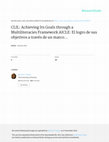Books by Beatrice Dupuy
International Encyclopedia of Education, vol. 10. Elsevier, 2023
This entry traces the developing role of literacy in second/foreign language education over the l... more This entry traces the developing role of literacy in second/foreign language education over the last few decades with an emphasis on what have been dubbed multiliteracies (New London Group, 1996) approaches. The first part of the essay discusses the expanded model of language and literacy offered by multiliteracies paradigms and how this has been taken up within North American foreign language teaching and learning. The second part then looks at emergent discussions within this field, which further the model, i.e., through attention to translingualism, multimodality, and affect.

Language Learning and Professionalization in Higher Education: Pathways to Preparing Learners and Teachers in/for the 21st Century., 2020
In this volume, language learning and professionalization are explored by addressing the existing... more In this volume, language learning and professionalization are explored by addressing the existing gap between pressing needs for enhanced soft skills in work environments wherein technology-mediated, multilingual communication is increasingly the norm, and current foreign language teaching and learning offerings in higher education. Considering theoretical, methodological, and pedagogical perspectives for preparing language learners and teachers in/for the 21st century, this volume’s eight chapters underscore that research findings should inform the design of learning experiences so that people’s communication needs in fast-changing work environments are met and the link between language education and professionalization, within a lifelong learning perspective, is sustained.
This co-edited volume explores the ideological construction of L2 Education as reflected in vario... more This co-edited volume explores the ideological construction of L2 Education as reflected in various professional and pedagogical discourses that circulate widely in the field.

To meet the goals of outlining a coherent pedagogical framework grounded in texts and the concept... more To meet the goals of outlining a coherent pedagogical framework grounded in texts and the concept of literacy and of presenting this framework in an accessible manner for novice collegiate FL teachers, A Multiliteracies Framework for Collegiate Foreign Language Teaching is organized into eight chapters and an afterword. Each chapter reconsiders traditional components of introductory and intermediate FL instruction (e.g., grammar and vocabulary, speaking, reading) according to a literacy orientation. The authors start with a discussion of what is familiar to readers and then emphasize how each of these traditional components works in concert to contribute to the development of students’ FL literacy.
Each chapter begins with an Overview that serves to introduce the topic and provide an outline of its contents. The Conceptual Background section summarizes essential research and outlines key concepts and is followed by Pedagogical Applications, which puts theoretical and conceptual knowledge into practice and provides instructional models and examples. The Final Considerations section summarizes the main points of a chapter before readers move on to the two application activities in Transforming Knowledge; one activity is a reflective journaling topic and the other a research topic. Finally, Key Resources and For Further Reading identify important references related to the topic of each chapter; the former provides annotations of the most important research on the topic, the latter does not. Each chapter additionally includes several Learning Activities intended to encourage readers to engage with and think critically about the chapter’s content.
Articles by Beatrice Dupuy
Intercultural Education Communication, 2021

ALSIC, 2018
Following calls for more extensive professional development (PD) opportunities for novice L2 teac... more Following calls for more extensive professional development (PD) opportunities for novice L2 teaching assistants (TA), this article reports on a PD activity implemented with six French TAs who read and discussed scholarly literature related to multiliteracies pedagogies through a digital social annotated reading (DSAR) platform in a discussion section concurrent to their methods course. Using the Community of Inquiry (CoI) framework developed by Garrison et al. (2000), participants' margin dialogues around academic articles were analyzed for indicators of cognitive, social, and teaching presence in order to examine the type and quality of knowledge co-construction that could emerge within this community of TAs. Findings reveal notably high levels of cognitive presence with respect to social and teaching presence, and compared to prior studies examining cognitive presence in more traditional types of digitally mediated discussion environments, such as discussion forums.
The Language Resource, 2013

Foreign Language Annals, 2013
Although participation in multilingual communities around the world has been understood to be the... more Although participation in multilingual communities around the world has been understood to be the raison d’être for foreign language study, the Communities standard has been portrayed as an extracurricular experience and more difficult to weave into instruction than the other standards. This article addresses two questions: (1) Does a study abroad experience facilitate meeting the Communities standard? and (2) How can collegiate foreign language curricula enhance the study abroad experience and fulfillment of the Communities standard? Current trends in study abroad participation by U.S. undergraduates and key research findings on study abroad related to the Communities standard are reviewed. Numerous recommendations for programmatic courses of action at home and abroad targeting a fuller consideration of the Communities standard in collegiate foreign language study are offered.
In G. Gorsuch & C. Davis (Eds.), Working theories for teaching assistant and international teaching assistant development . (pp. 267-310). Stillwater, OK: New Forums Press., 2012
In H. W. Allen & H. H. Maxim (Eds.), Educating the Future Foreign Language Professoriate for the 21st Century (pp. 171-191). Boston, MA: Heinle Cengage. , 2011

Latin American Journal of Content & …, 2011
This article examines how CLIL goals can best be realized by adopting a multiliteracies (New Lond... more This article examines how CLIL goals can best be realized by adopting a multiliteracies (New London Group, 1996) framework as it can provide 1) the critical link between content and language and allow students to not only develop their ability to produce and interpret texts, but also expand their critical awareness of the relationship between one another, discourse conventions, and social and cultural contexts, that our times demand and 2) an organizing principle for CLIL teachers that potentially promotes more principled curricular and pedagogical decision making and practices. Accordingly, I begin by examining shared rationales and goals between CLIL and a multiliteracies framework. Next, I highlight the ways in which to organize CLIL instruction through a multiliteracies framework. Finally, I conclude by presenting a model multiliteracies-based CLIL lesson.
Academic Exchange Quarterly, 2006
In S. Wilkinson (Ed.), Insight from Study Abroad for Language Programs (pp. 134-156). Boston, MA: Heinle Cengage., 2006
In G. H Beckett & P. Chamness Miller (Eds.), Project-based Learning in Second Language Education: Past, Present and Future, Research in Second Language Learning (pp. 195-214) Greenwich, CT: Information Age Publishing, Inc. , 2006
In Bamford, J, & R. Day (Eds.), Extensive Reading Activities for Language Teaching (pp. 151-152). Cambridge (UK): Cambridge University Press., 2004
Foreign Language Annals, 2000
This article examines content-based instruction as a possible strategy for easing students' trans... more This article examines content-based instruction as a possible strategy for easing students' transition from beginning to advanced foreign language courses, as well as for developing students' interest in pursuing language study beyond those courses sponsored and protected by an institutional foreign language requirement. Four principal sections organize this article. First, the theoretical underpinnings of content-based instruction are reviewed. In the second section, four common content-based instruction models are outlined and compared. The third section examines recent research findings in content-based instruction and offers advice 6n how to implement a content-based instruction program in a university context. The final section highlights future research needs.

System, 1999
Evidence shows that aural comprehensible input plays a critical role in the early stages of langu... more Evidence shows that aural comprehensible input plays a critical role in the early stages of language acquisition. While uncontrolled casual conversations may be too dicult for beginning and intermediate foreign language students to comprehend, Narrow Listening, the repeated listening of several brief tape-recorded interviews of pro®cient speakers discussing a topic both familiar and interesting to the acquirers, oers them a valuable and rewarding alternative. In the present study, a survey of beginning and intermediate college French as a foreign language students' reactions to Narrow Listening and their assessment of its impact on their language development was conducted. Results indicate that students found Narrow Listening to be interesting, very helpful in improving listening comprehension,¯uency, and vocabulary, and in increasing their con®dence with French. # System 27 (1999) 351±361 www.elsevier.com/locate/system 0346-251X/99/$ -see front matter # 1999 Elsevier Science Ltd. All rights reserved. P I I : S 0 3 4 6 -2 5 1 X ( 9 9 ) 0 0 0 3 0 -5 *











Uploads
Books by Beatrice Dupuy
Each chapter begins with an Overview that serves to introduce the topic and provide an outline of its contents. The Conceptual Background section summarizes essential research and outlines key concepts and is followed by Pedagogical Applications, which puts theoretical and conceptual knowledge into practice and provides instructional models and examples. The Final Considerations section summarizes the main points of a chapter before readers move on to the two application activities in Transforming Knowledge; one activity is a reflective journaling topic and the other a research topic. Finally, Key Resources and For Further Reading identify important references related to the topic of each chapter; the former provides annotations of the most important research on the topic, the latter does not. Each chapter additionally includes several Learning Activities intended to encourage readers to engage with and think critically about the chapter’s content.
Articles by Beatrice Dupuy
Each chapter begins with an Overview that serves to introduce the topic and provide an outline of its contents. The Conceptual Background section summarizes essential research and outlines key concepts and is followed by Pedagogical Applications, which puts theoretical and conceptual knowledge into practice and provides instructional models and examples. The Final Considerations section summarizes the main points of a chapter before readers move on to the two application activities in Transforming Knowledge; one activity is a reflective journaling topic and the other a research topic. Finally, Key Resources and For Further Reading identify important references related to the topic of each chapter; the former provides annotations of the most important research on the topic, the latter does not. Each chapter additionally includes several Learning Activities intended to encourage readers to engage with and think critically about the chapter’s content.